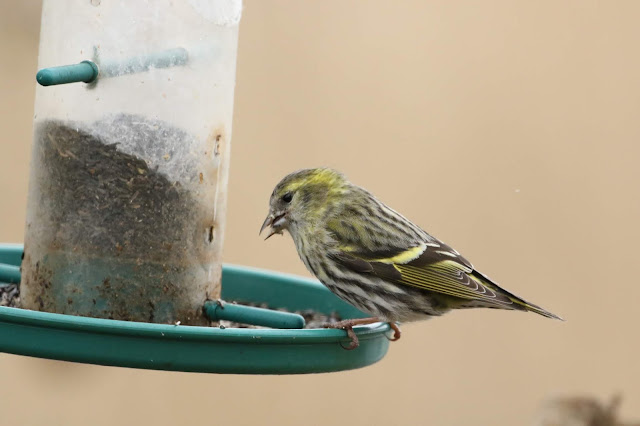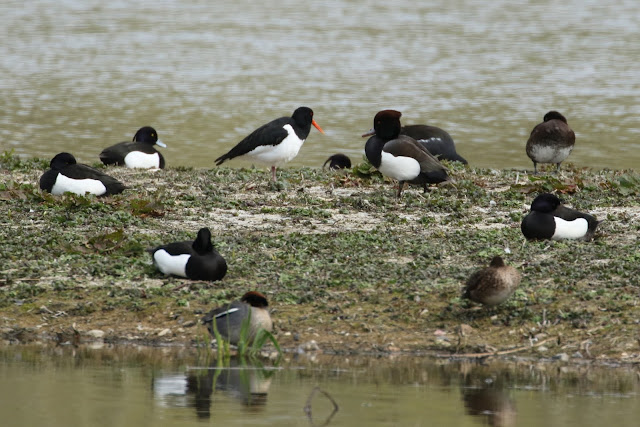Sunday 26th April - the day in the Abington NatureWatch programme that we had planned to visit Lackford Lakes .... plans made prior to the coronavirus 'lock-down', and plans which regrettably but quite correctly were shelved, for now at least.
As we can't
actually visit at the moment, the suggestion was that we might have a 'virtual' visit instead - until such time as we are able to get there once again - hopefully in the not too distant future.
So off we go! Meeting at the Visitor's Centre, before a quick nip inside to check the map and sightings board, and to see what's on the feeders - there's usually something there, like a Siskin, or a Robin or a Blue Tit.
Siskin
Robin
Blue Tit
... then it's off to the Winter Hide and a look across the Sailing Lake - always guaranteed to be a few ducks, swans and geese there:
The Sailing Lake from Winter Hide
Mallard
Tufted Duck
Pochard
Teal
Gadwall
Canada Goose
An elegant Mute Swan in the morning sun
Mute Swan
A Coot creating an impressive 'bow-wave'
Walking alongside the Sailing Lake, there's always the chance of seeing a Water Rail lurking in the reeds, or a Reed Bunting with food for its young, or a pair of Blackcap.
The normally elusive Water Rail searching for food under the feeders in the frozen reedbed
Male Reed Bunting
Male and female Blackcap
Just a little further on are the hides that overlook The Slough, and - with a little patience - the best chance of seeing a Kingfisher, as well as other birds like Grey Heron, Little Egret and a variety of ducks, geese and waders.
View over The Slough
Kingfisher!!
if you're lucky, they can get really quite close!
... and if you're even luckier, you'll get to see one catch a fish!
[photo Derek T]
Grey Heron and Greylag goose in the morning sun
Grey Heron
Juvenile Grey Heron
Grey Heron
Little Egret
[photo Barry B]
Shelduck
Something puts up the Gulls...
maybe it was this Canada Goose on the warpath!

the pair of Egyptian Goose are far less excitable
An Oystercatcher amongst the Tufted Duck and a Teal
Oystercatcher
A wonderfully camouflaged Snipe, feeding in the margins, near some resting Shoveler

The Slough and The Shallows
One of the great features of Lackford Lakes is the variety of habitats in a relatively small area, and just a little further on from The Slough, the path winds through the reeds, then away from the lakes and into the woods.
A pair of Sedge Warblers courting
In the middle of the woods, there is a 'feeding log' where usually quite shy birds have become accustomed to people being quite close by - and where there's even the chance of seeing a Wood Vole as it dashes out from under the log for food.
A cheeky little Wren
Robin singing
Marsh Tit
Marsh Tit at the feeding log
and a Nuthatch doing the same.
Nuthatch
Wood Vole
On the far side of the woods we come to a more open area, with smaller lakes surrounded by scrub and reeds - the ideal place to look for damselflies, dragonflies and butterflies on a bright sunny day.
Comma
Four-spotted Chaser
Common Blue Damselfly
Common Blue Damselfly
Common Blue Damselfly
Banded Demoiselle
Banded Demoiselle
Ringlet
And then finally, we get to the 'lakes at the end of the path', where there are always a few Cormorant and other birds not seen hitherto. And from there, we retrace our steps back to the visitors centre, passing a reedbed where, on a hot sunny day, where we may see some lizards basking.
Wigeon
A trio of Cormorant
Siskin feeding in the alder
Lapwing
An Egyptian Goose keeping the golf course lawn tidy
The way back to the visitors centre, passed a large open reedbed
Common Lizards
A group of young Common Lizards
A Common Lizard and a large parasitic wasp
A shy goodbye!
And that's it - u
ntil next time - when we can all get to see this for real!
Based on an idea by Jennifer H. All wildlife photos taken at Lackford Lakes by Andy M (unless otherwise indicated), and with scenery photos from The Suffolk Wildlife Trust website.



































































No comments:
Post a Comment